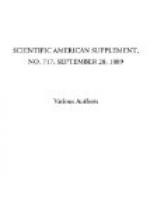Many processes have from time to time been proposed to obtain ammonia from other sources. The distillation of turf, which contains upward of 3 per cent. of nitrogen, has received much attention, and a large number of inventors have endeavored to produce ammonia from the nitrogen of the air; but none of these processes has to my knowledge been successful on a manufacturing scale.
My attention was called to this subject at an early part of my career. Already, as far back as 1861, I undertook experiments to utilize, for the production of ammonia, waste leather, a waste material of animal origin at once abundant and very rich in nitrogen, containing from 12 per cent. to 15 per cent. of this element. Distillation in iron retorts yielded about half the nitrogen of this material in the form of ammonia, the carbon remaining in the retorts containing still from 6 per cent. to 8 per cent. Distillation with a moderate quantity of hydrate of lime increased the yield of ammonia only by 1 per cent. to 11/2 per cent. A rather better result was obtained by distilling the ground residual carbon with hydrate of lime, but this operation proceeded very slowly, and the total yield of ammonia still remained very far below the quantity theoretically obtainable, so that I came to the conclusion that it was more rational to utilize the leather, reduced to powder by mechanical means, by mixing it directly with other manures.
A few years later I became connected with a large animal charcoal works, in which sulphate of ammonia was obtained as a by-product. Here again I was met with the fact that the yield of ammonia by no means corresponded with the nitrogen in the raw material and that the charcoal remaining in the retorts contained still about half as much nitrogen as had been present in the bones used.
From this time forward my attention was for many years given exclusively to the soda manufacture, and it was only in 1879 that I again took up the question of ammonia. I then determined to submit the various processes which had been proposed for obtaining ammonia from the nitrogen of the air to a searching investigation, and engaged Mr. Joseph Hawliczek to carry out the experimental work.




